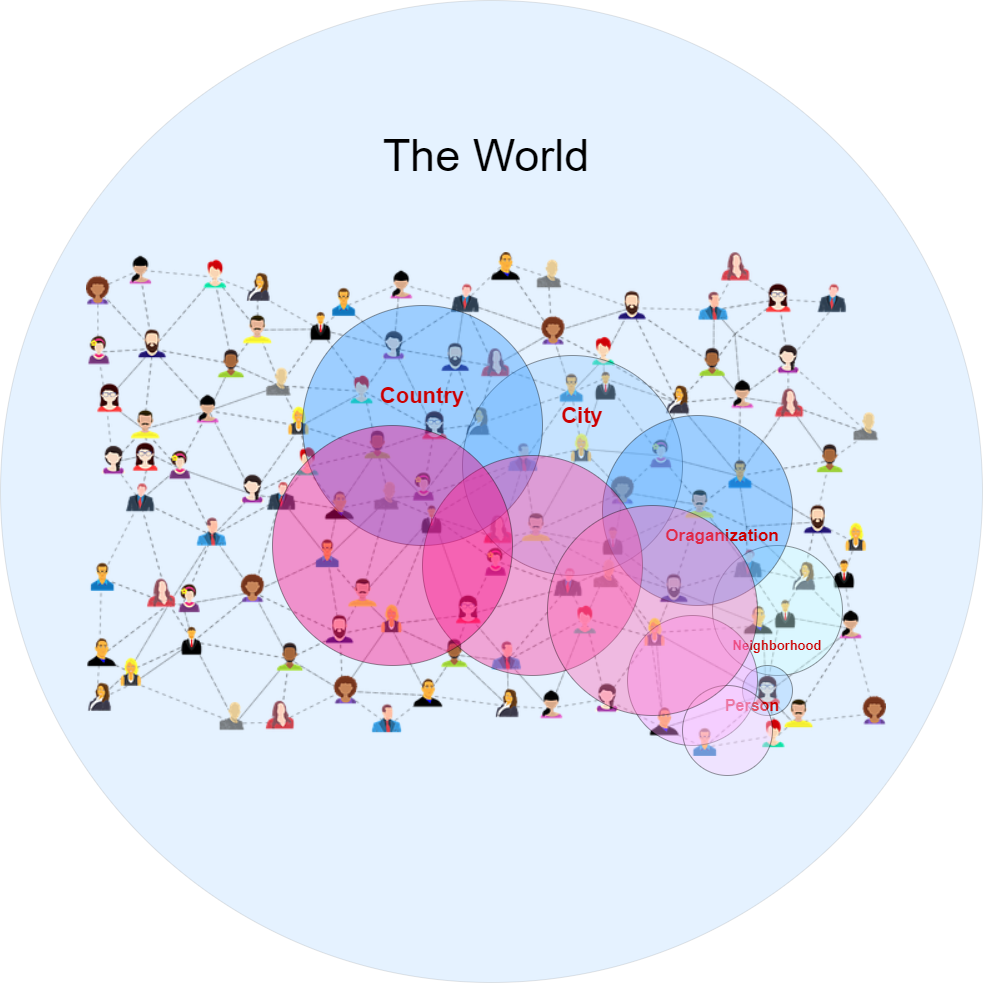
Not digitally connected, but consciously connected.
This article discusses three approaches for organizations to break free from the perpetual competition-based culture that currently exists within them and their interconnections with other organizations.
It also discusses a way for organizations to look beyond their immediate function and to be connected and integrated with Earth from a human, environmental and wildlife viewpoint.
Approach: All people are always treated with kindness, respect, and compassion. All interactions with people outside of the organization should be treated in the same way—in a humanistic way and not an automated way.

When an organization is formed and before any organizational activity begins. The first question that should be asked is, How do we ensure we meet this approach?
This approach applies to all types of organizations, charity, non-profit, government, profit, and all organizations large or small.
The message to the people they employ should be along the following lines:
- At the heart of our organization is kindness, respect, and compassion for all people. Treat each other this way, and treat anyone outside your organization the same way.
- All people in an organization are equal; you are hired because you are talented in your field of work. But from the janitor to the CEO, you all have equal status, and there is no power control at any level.
Where possible, a conscious effort should be made to support all people in need outside the organization, local communities, cities, countries, and other parts of the world.
Most organizations adopt strategies to obtain financial rewards, creating a culture where every employee and department competes with each other and other similar organizations for greater financial rewards. If the reward is not financial, then it is for status or power.
Organizations introduce incentives on the side so people feel they are satisfied working for them. This method is wrong because it doesn't stem from the core of the approach mentioned; it's just there to give you the impression that you are valued.
In interactions outside of the organization, there is a disconnect. An example quote might go, "Have you heard about those awful things happening to those people over there?" The people over there and the people in the organization are seen as separate entities. The attitude is that we must continue with our own daily activities. "Those people over there" could apply to people in your neighborhood, city, country, or other parts of the world.
The terms office culture, organizational culture, and business culture should not exist; they should be eliminated. The mere thought of having them is the beginning of a split between your organization, other organizations, and the rest of humanity.
At the core of any organization should be kindness, respect, and compassion for all its members. Depending on the outreach of an organization i.e., community, city, country, or world, it should support people at all these levels, not just those working in the organization.
Approach: Respect for everything around us and taking care of our planet, the only place we can live. No matter what you think about climate change, or even if you think it has nothing to do with humans, it is our responsibility to protect the environment. The relationship between the environment and all living things is one-to-one.

Organizations should be aware of all products in use. Including where they come from, how they are sourced, and the impact they will have on the environment. Educating people is important; organizations should educate people about the environment and even ask prominent environmentalists to talk about the environment.
They should educate people about the state of the environment around the world, hold public talks, promote green living in their communities, and promote whole foods and clean eating. If you have a large enough cafeteria, use only eco-friendly products, and where possible, create open green spaces in and around your facility.
Until recently, unless you were part of an environmental group, there was no connection between the organization and the environment; then, when the alarm bells started going off, people began to pay more attention to it.
For many organizations, this approach is an afterthought. Retroactive measures have been taken to comply with environmental regulations.
One could assume within the organization the following conversation is being had: As an organization, we are now required by the authorities to follow these regulations, and we need to show people using our organization how green and environmentally friendly our organization is because we cannot lose the revenue of the green movement.
A common example of organizations retroactively adopting green policies is a supermarket near you. Their entire operation is to cover all their bases for maximum profit, but without changing their mindset to only sell organically grown produce, only sell sustainably sourced products, and help their local community build green spaces at all their locations, they will not go wholeheartedly green because their commitment leans more towards financial gain.
Around the world, a few supermarkets and other businesses are doing well in terms of environmental friendliness. However, the majority of people would see an immediate increase in their bill if the price of environmental protection increases.
An organisation should integrate environmental considerations throughout all aspects of its operations, not merely because regulations regarding the environment are enforced on them.
Similar to an organization being a human-appreciative workplace, environmental responsibility starts with the individual, but extends to your organization, your building, neighborhood, city, country, and worldwide.
The focus is on organizations because this is where most of the resources are used. Most organizations expect their employees to travel, which requires transportation that relies on fossil fuels for energy. If organizations are not using clean energy, then organization and their buildings are only increasing pollution levels. All the other resources used to maintain and provide an environment for employees to work in.
There are other businesses that depend on workers being physically present, for example, retail, food, and manufacturing businesses. These types of organizations should adapt a clean energy only policy, for buildings, manufacturing, and the transportation of goods and people.
Humans cannot survive without a healthy environment, but Earth can survive without humans.
Approach: Organizations should adopt a biocentric attitude; all wildlife is equally important as the human race and should be treated with equal importance.

Organizations should highlight the plight of certain areas of the natural world to the people they employ and, where possible, support the cause to save endangered animal species; educate people on how wildlife is being disrupted; and hold public talks about the situation. The measure of help does not have to be monetary.
Unless you belong to an animal rights or environmental group. There is little connection between organisations and the conservation of endangered wildlife. There is a disconnect; that is happening over there, but we are not affected by it. We may donate to animal rights or environmental organisations, but that is the extent of our involvement.
Wildlife - We don't see it every day because most people live and work in cities. We obtain snippets of knowledge from news broadcasts when a specific species is discussed; people hear it and then forget about it.
Environmental changes also affect the survival of many animal species. We have a responsibility to protect all wildlife, large and small, even if there are no problems. We destroy their habitats by seizing land and natural resources. We share this planet with them; it is important to remember that we are not separate from the animal kingdom; we are a part of the animal kingdom.
Humans cannot survive without the natural world, but the natural world can survive without humans.
Many of these organizations have the brainpower, technology, and money to solve many of the social and environmental problems and create a better world. However, the focus is more on consumerism and the fastest and cheapest way to make products for maximum profit.
The only reason organizations take an environmental stance is because regulations are enforced and organizations realize that millions of people are now environmentally conscious, and they don't want to miss out on this consumer market.
Any additional overhead associated with producing an environmentally friendly product is added to the cost of the product and passed onto the consumer.
Another area is the cost of defense spending. While a country's government is jostling for superiority by increasing their military power. All the money spent on defense would have solved many social problems. This money would also be better used for research in all fields and to explore the universe for the benefit of humanity. The protection argument can be made in the other direction; all countries should not hold any armaments at all.
Similar to a DevOps pipeline, the jobs in the pipeline are connected; one job must succeed before moving onto the next job to get a successful build at the end.
The connection and dependency analogies of a DevOps pipeline can be made; all things on Earth are connected and have a dependency on each other. Continuing that analogy, we could see ourselves (the human race) as the final deployment stage; if the things before the deployment do not succeed, the deployment cannot go ahead. A completely new pipeline can be created where the deployment stage is something totally different.
Earth-Connected: Because everything on the planet is connected, we cannot just focus on the people; we cannot just focus on the environment or the wildlife; many of us see ourselves as separate entities from people living in other parts of the world, the wildlife, the environment, and nature as a whole.
All these things are connected, and all these things must be at the core of every organization, making it an Earth-Connected Organization.
The discussion of all things on Earth and beyond being connected is not a new one; it has been discussed by many scientists, philosophers, and religious leaders.
© Lightnetics 2024